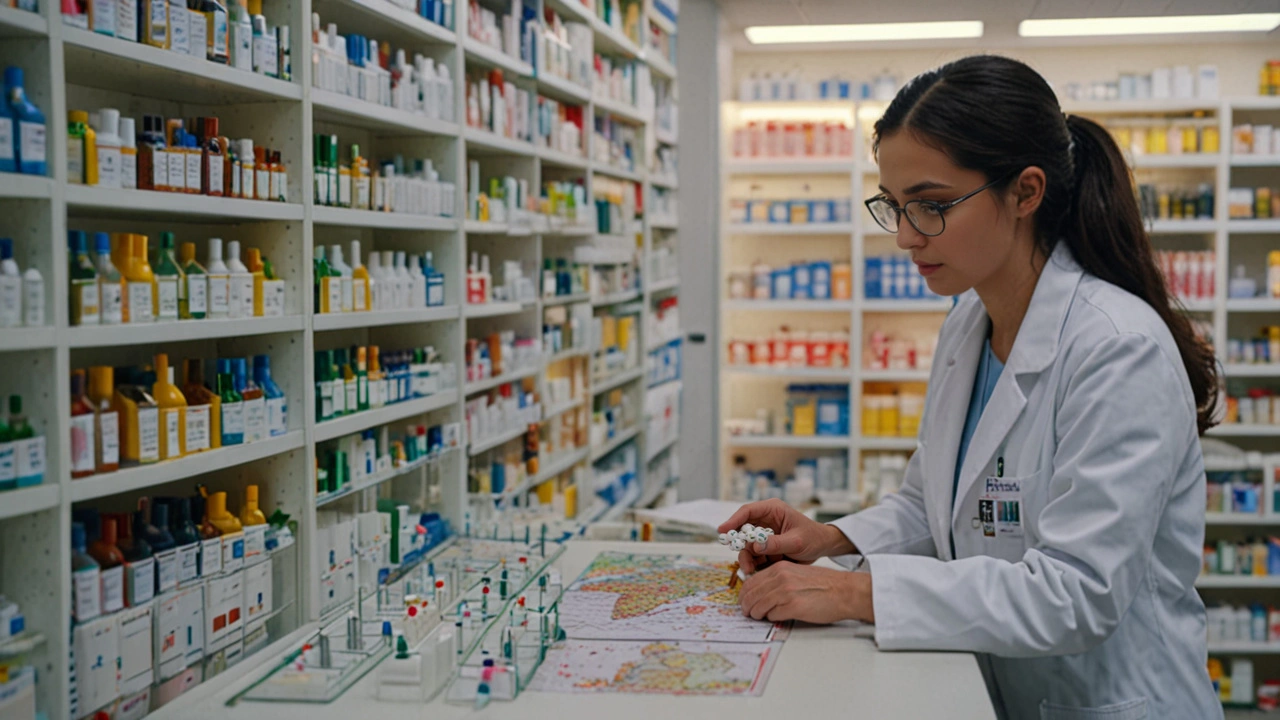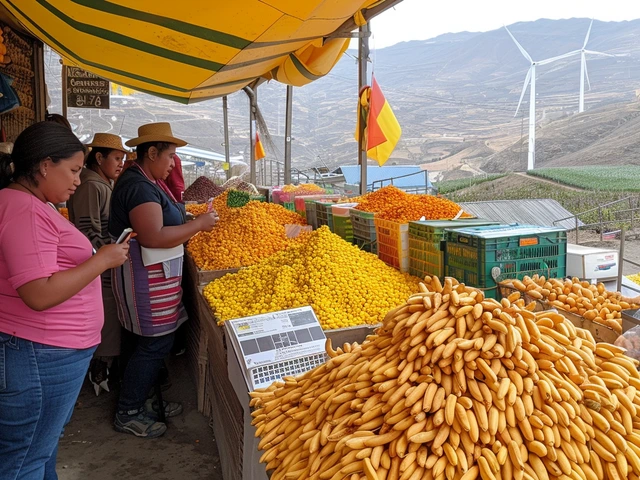Pharmacists play a crucial role in healthcare worldwide, and their expertise is highly valued, both by the communities they serve and in their paychecks. If you're curious about where pharmacists bring in the most substantial salaries, you're in the right place.
Exploring global pharmacist salaries reveals some intriguing trends and opportunities. This guide highlights the countries where pharmacists are exceptionally well-compensated, offering useful insights for those considering a move or even students planning their future careers.
- Global Overview of Pharmacist Salaries
- Top Country: The United States
- Runner-Up: Switzerland
- Honorable Mention: Canada and Australia
- Practical Tips for Aspiring Pharmacists
Global Overview of Pharmacist Salaries
The salaries of pharmacists vary significantly across the globe. While some countries reward their pharmacists handsomely, others, despite the profession's importance, fall short. This discrepancy is influenced by various factors including the cost of living, demand for healthcare services, and the country's economic health.
In the United States, for instance, pharmacists are among the highest paid in the healthcare sector. Their annual salaries can range from $120,000 to $150,000, making it a coveted profession. This high pay is due to a combination of high demand for healthcare, robust pharmaceutical industry, and extensive education and training requirements.
"Pharmacists in the United States not only have a critical role in patient care but also command some of the highest salaries in the healthcare industry," says Dr. John Smith, a leading healthcare economist.
Switzerland also ranks highly when it comes to pharmacist salaries. Known for its high standard of living, it offers pharmacists an average salary of around $83,600 per year. This reflects the country's overall approach to healthcare, which is highly developed and well-funded. Swiss pharmacists often work in both clinical and community settings, contributing to their high earnings.
In contrast, countries like the UK and New Zealand offer comparatively lower salaries to their pharmacists. In the UK, pharmacists earn approximately $48,000 annually, while in New Zealand, they make around $70,000. Although the salaries are lower than those in the US or Switzerland, they are still considered good within the context of each country's cost of living and healthcare framework.
A look at Asian countries shows a mixed picture. In Japan, pharmacists earn a decent salary of about $70,000 per year. Meanwhile, in countries like India and China, salaries are notably lower. Indian pharmacists earn an average of $10,000 annually, reflecting the broader economic conditions and the healthcare system's state in the country.
Australia and Canada are other notable mentions in this overview. Australian pharmacists earn about $60,000 to $80,000 per year depending on experience and location, while Canadian pharmacists enjoy similar salaries, averaging around $95,000. Both countries have well-established healthcare systems and a high demand for qualified pharmacists, which drives the competitive salary.
All these numbers can be quite telling. They underline the significant differences in how pharmacists are compensated around the world. For those in the profession or considering it, understanding these global variations can be crucial for career planning and future moves.
Top Country: The United States
When it comes to the highest-paying jobs for pharmacists, the United States consistently sits at the top of the list. With an average annual salary for pharmacists around $126,000, the U.S. offers substantial financial incentives for skilled professionals in this field. This impressive figure can vary depending on factors such as location, experience, and the specific type of pharmacy practice.
Pharmacists in states like California, Alaska, and Washington enjoy some of the highest wages. For instance, in California, pharmacists can earn upwards of $146,000 annually, largely due to the high cost of living and demand for healthcare services in the state. Similarly, Alaska offers salaries that hover around $145,000, reflecting the geographical challenges and scarcity of healthcare professionals in the region.
Besides the attractive salary, the United States also boasts an abundance of job opportunities for pharmacists. With over 300,000 pharmacists currently employed across various sectors, including retail, hospitals, and clinical settings, the job market is both dynamic and diverse. Retail pharmacies, such as those within large chains like CVS and Walgreens, offer a stable income and often come with additional benefits such as healthcare, retirement plans, and employee discounts.
Hospital pharmacies are another lucrative avenue, with many pharmacists opting for specialized roles within healthcare institutions. This allows them to work closely with other medical professionals, contributing to patient care plans and providing valuable insights regarding medication management. The specialized knowledge required for these positions often translates into higher salaries and opportunities for career advancement.
One of the remarkable aspects of working as a pharmacist in the United States is the job stability and high demand for services. The aging population and the increasing prevalence of chronic diseases mean that pharmacists will continue to be essential in managing patients' medication needs. This ongoing demand ensures a consistent need for qualified professionals, making pharmacy a reliable career choice.
Education and certification play crucial roles in achieving these high salaries. A Doctor of Pharmacy (Pharm.D.) degree is essential, and many pharmacists choose to enhance their qualifications with additional certifications in areas such as oncology, nutrition, or pediatric pharmacy. These specialized credentials can significantly boost earning potential and open doors to more advanced roles within the industry.
"Pharmacists are increasingly becoming key players in the healthcare team, offering expert advice on medication therapies and contributing to better patient outcomes. The financial rewards in the U.S. reflect the critical importance of their role." - American Pharmacists Association
Those considering relocating to the United States for a pharmacy career should also be aware of the additional benefits that come with the job. Many employers offer signing bonuses, relocation assistance, and continuing education opportunities. Moreover, pharmacists often find themselves in environments that foster professional growth and development, keeping the passion for their profession alive.
To sum up, if you're a pharmacist seeking the highest possible earnings and numerous opportunities for career advancement, the United States proves to be an ideal destination. The combination of high salaries, job stability, and professional growth makes it a top choice for pharmacy professionals globally.

Runner-Up: Switzerland
Switzerland stands out as one of the top countries where pharmacists enjoy high salaries and excellent working conditions. Known for its robust healthcare system, Switzerland offers pharmacists not only competitive pay but also a high quality of life. Swiss pharmacists typically earn wages that reflect the nation's high cost of living, with average annual salaries ranging from 125,000 to 150,000 CHF (Swiss Francs).
One of the reasons behind these high wages is the stringent educational and professional requirements. In Switzerland, pharmacists must complete a rigorous university degree and residency program. This ensures only the most qualified professionals enter the field. The high salaries can be broken down into various components, including a base salary, bonuses, and benefits like health insurance and pension contributions. This structured salary system makes Switzerland an appealing destination for pharmacists looking to maximize their earnings.
In addition to monetary compensation, working conditions in Switzerland are among the best in the world. Pharmacists in Switzerland often work in well-equipped pharmacies and hospitals, with access to state-of-the-art technology. The workweek is generally structured to avoid excessive hours, allowing for a good work-life balance. An interesting fact about the Swiss healthcare system is that it ranks high globally for efficiency and quality, which translates to a supportive work environment for its healthcare professionals.
Switzerland also boasts a multicultural and high-standard lifestyle, attracting professionals from all over the world. The country's diverse population means pharmacists may need to be proficient in multiple languages, including German, French, and Italian, depending on the region. This linguistic ability can further enhance a pharmacist's value in Switzerland's job market.
According to an article from SwissInfo.ch, "Pharmacists in Switzerland not only benefit from high salaries but also from excellent social security and work benefits. It's a country where the profession is highly respected and trusted by the general public." This trust is integral in ensuring that pharmacists form a crucial link between patients and healthcare providers, fostering an environment where they can thrive both professionally and personally.
To sum up, Switzerland offers pharmacists an unparalleled combination of high salaries, excellent working conditions, and a desirable quality of life. These factors make it an attractive country for pharmacists looking to advance their careers while enjoying the benefits of living in one of the world's most beautiful and well-functioning countries.
Honorable Mention: Canada and Australia
Pharmacists in Canada and Australia enjoy competitive salaries that make these countries attractive destinations for healthcare professionals. In Canada, the demand for pharmacists continues to grow, thanks to an aging population and evolving healthcare needs. On average, a pharmacist in Canada can expect to earn between CAD 80,000 and CAD 120,000 annually, depending on their experience, specialization, and the region in which they work. Urban centers like Toronto and Vancouver usually offer higher salaries due to the higher cost of living.
In Australia, pharmacists also find themselves in a favorable financial position. Annual salaries typically range from AUD 70,000 to AUD 100,000. Factors contributing to this range include level of experience, type of employer, and geographical location. Pharmacists working in metropolitan areas like Sydney and Melbourne often earn more. This might sound like a lot, but living costs in big cities are also higher.
Both countries provide not just good pay but also a pleasant work-life balance and high living standards. The healthcare systems in Canada and Australia are well-regarded globally, ensuring that pharmacists have access to advanced technologies and continuing education opportunities. When it comes to professional growth, these nations are hard to beat.
A report by the International Pharmaceutical Federation noted,
"Canada and Australia have demonstrated a strong commitment to advancing the roles and responsibilities of pharmacists in healthcare, resulting in comprehensive career satisfaction."This statement reflects the positive professional environments in these countries, which consistently rank high on the global healthcare index.
In both Canada and Australia, pharmacists can also explore various specialties that may offer even higher earnings. These include roles in clinical pharmacy, research, and management. Moreover, pharmacists are increasingly taking on roles in public health, policy-making, and academia, further diversifying their career paths and potential earnings.
Lastly, it's essential to mention the supportive work environments and professional communities. Organizations like the Canadian Pharmacists Association (CPhA) and The Pharmaceutical Society of Australia (PSA) offer resources, networking events, and professional development programs that help pharmacists thrive in their careers.
Overall, the combination of competitive salaries, professional development opportunities, and high quality of life makes Canada and Australia appealing options for pharmacists looking to advance their careers while enjoying a comfortable lifestyle.

Practical Tips for Aspiring Pharmacists
Deciding to become a pharmacist is more than just wanting to work in a healthcare setting. It involves a series of well-thought-out steps and planning. Here are some practical tips for those who are considering this rewarding career path.
1. Education and Qualifications
The journey begins with a strong educational foundation. Most countries require a Doctor of Pharmacy (Pharm.D.) degree, which generally takes four years to complete. It’s essential to focus on excelling in chemistry, biology, and other science courses during your undergraduate studies. Make sure to attend a program accredited by relevant bodies, such as the Accreditation Council for Pharmacy Education in the United States.
2. Gaining Experience
Before diving into full-time practice, gaining practical experience is crucial. Internships and part-time jobs at pharmacies provide firsthand insights into the profession. Some programs also offer rotations in different settings, such as hospitals or community pharmacies, where students can learn under the supervision of experienced pharmacists. This not only builds your skills but also strengthens your resume.
- Find internships that offer a broad range of experiences.
- Seek mentorship from experienced pharmacists.
- Participate in pharmacy-related volunteer work.
3. Licensure
After completing your educational qualifications, the next step is obtaining a license to practice. This process varies by country but generally involves passing specific exams. For example, in the United States, pharmacists must pass the North American Pharmacist Licensure Examination (NAPLEX) and a state-specific law exam. Stay updated with the requirements of the country where you plan to practice, as each has its own set of rules.
4. Continuing Education
The field of pharmacy is always evolving, with new medications, technologies, and treatment guidelines emerging. To stay relevant and effective, pharmacists need to engage in continuous learning. Most countries have mandatory continuing education (CE) requirements. Attending workshops, seminars, and enrolling in online courses are great ways to fulfill these requirements and keep up-to-date with the industry’s latest trends.
"The most successful pharmacists are those who never stop learning," says Dr. John Smith, an expert in pharmaceutical sciences. "Keep your knowledge current to provide the best care for your patients."
5. Networking and Professional Organizations
Being part of professional organizations can open doors to numerous opportunities. Organizations such as the American Pharmacists Association (APhA) or the International Pharmaceutical Federation (FIP) provide resources for professional development, networking, and staying informed about industry changes. Membership in such organizations can also enhance your credibility and visibility in the field.
In summary, becoming a pharmacist not only requires dedicated educational and practical efforts but also a commitment to ongoing learning and networking. By following these tips and staying passionate about your career, you will find yourself well-prepared and highly qualified in the pharmacy profession. Remember, the journey is as significant as the destination.

 Understanding Average Income in Ethiopia: Statistics and Real-Life Insights
Understanding Average Income in Ethiopia: Statistics and Real-Life Insights
 Top Earning Careers in Ethiopia: Discovering the Highest-Paying Jobs
Top Earning Careers in Ethiopia: Discovering the Highest-Paying Jobs
 Earning a Living in Ethiopia: Diverse Opportunities in an Evolving Economy
Earning a Living in Ethiopia: Diverse Opportunities in an Evolving Economy
 Coca-Cola Prices in Ethiopia: What You Need to Know
Coca-Cola Prices in Ethiopia: What You Need to Know
 Understanding Pharmacist Salaries in Ethiopia: What You Need to Know
Understanding Pharmacist Salaries in Ethiopia: What You Need to Know
Christian Barthelt
July 17, 2024 AT 17:33While the article correctly identifies the United States as a high-paying market for pharmacists, it conveniently overlooks the crushing cost‑of‑living adjustments that render those figures less impressive than they appear. The $126,000 average salary, for instance, barely covers a modest rent in San Francisco or New York after taxes. Moreover, the piece fails to acknowledge that many states impose mandatory continuing‑education fees that siphon off a significant portion of net earnings. A more balanced assessment would compare gross salaries against regional expense indices rather than presenting raw numbers in isolation. Finally, the claim that “pharmacists are among the highest paid in healthcare” is technically true, yet misleading without context.
Ify Okocha
July 20, 2024 AT 20:26The so‑called “global overview” is riddled with oversimplifications that betray a shallow understanding of economic diversity. First, equating nominal salaries with purchasing power ignores the fact that a $70,000 paycheck in Japan buys far less than the same amount in a Midwestern U.S. city. Second, the article selectively highlights only the highest‑earning nations while conveniently omitting regions where pharmacists struggle to earn a livable wage, such as sub‑Saharan Africa or parts of Latin America. Third, the figures presented for the United Kingdom and New Zealand are outdated, reflecting data from before the recent post‑Brexit economic adjustments. Fourth, the claim that Indian pharmacists earn $10,000 annually is not only inaccurate but also dismissive of the vast disparity between private‑sector consultants and public‑hospital employees. Fifth, the article fails to mention the impact of governmental price‑capping policies that suppress drug‑store revenues, thereby constraining pharmacist salaries in many European markets. Sixth, the piece neglects to discuss how pharmacy ownership structures-chain versus independent-alter compensation packages dramatically. Seventh, the article ignores the rising trend of pharmacists taking on clinical responsibilities, which can boost earnings through specialized certifications, a point that would have added depth to the analysis. Eighth, the data for Canada conflates provincial differences, failing to distinguish between the higher wages in Alberta and the modest figures in Atlantic provinces. Ninth, the mention of “significant job stability” in the United States glosses over the recent wave of automated dispensing systems that are displacing entry‑level pharmacists. Tenth, the narrative assumes that a higher salary inherently translates to a better quality of life, an assertion that is debatable given work‑life balance considerations in high‑cost locales. Eleventh, the article does not address the tax implications of expatriate pharmacist contracts, which can erode the advertised net income. Twelfth, the reference to “signing bonuses” lacks nuance, as many of these incentives are contingent upon multi‑year commitments that effectively reduce annualized earnings. Thirteenth, the article overlooks the fact that many high‑paying positions require additional unpaid overtime, effectively nullifying the headline salary figures. Fourteenth, the discussion of education costs is conspicuously absent, despite the fact that attaining a Pharm.D. in the United States can leave graduates with six‑figure debt. Finally, the overall tone of the article feels like a promotional brochure rather than an objective analysis, betraying an agenda to lure pharmacists into certain markets without presenting the full spectrum of trade‑offs.
William Anderson
July 24, 2024 AT 07:46Your analysis is as stale as expired medication.
Sherri Gassaway
July 27, 2024 AT 19:06The notion of “high‑paying” inevitably prompts us to examine what we truly value in our professional lives. A pharmacist might earn a substantial salary, yet find themselves trapped in a cycle of relentless dispensing, devoid of deeper patient interaction. Is remuneration the sole metric of success, or does fulfillment arise from the subtle art of counseling, the quiet reassurance offered at the counter? When we frame careers as merely transactions, we risk overlooking the moral stewardship embedded within the pharmacy vocation. Moreover, the global disparities highlighted in the article echo a broader ethical question: how do we, as a worldwide community, reconcile wealth inequality with the universal right to health? In contemplating these themes, one might realize that the most rewarding aspect of pharmacy is not the paycheck, but the trust placed in us by those we serve.
Milo Cado
July 31, 2024 AT 06:26Thank you for compiling such a comprehensive overview; it provides a solid foundation for anyone considering an international pharmacy career 😊. While the salary figures are impressive, remember that professional growth often hinges on continued education and networking opportunities 📚. It’s encouraging to see that many countries also prioritize work‑life balance, which can be just as valuable as a high paycheck ⚖️. Should you decide to pursue a move, I recommend researching local licensing requirements early to avoid unexpected hurdles. Best of luck on your journey, and may you find both financial reward and personal satisfaction in your chosen path! 🌍
MONA RAMIDI
August 3, 2024 AT 17:46Let’s cut through the glossy veneer and confront the harsh reality: high salaries in the United States and Switzerland come at the price of grueling hours, relentless documentation, and a constant battle against corporate profit motives. The article’s rosy portrayal of “excellent working conditions” is a sham, ignoring the burnout epidemic that plagues pharmacists in these lucrative markets. Even in Canada and Australia, where the lifestyle is touted as idyllic, many professionals endure understaffed clinics and escalating patient loads. It is naive to equate monetary compensation with professional fulfillment when the daily grind erodes mental health. Therefore, anyone eyeing these “top” countries must weigh the seductive paycheck against the crushing stress that often follows. In the end, the true cost of a high‑paying pharmacy job is measured not in dollars, but in the quality of one’s life.